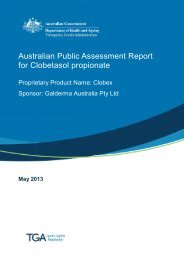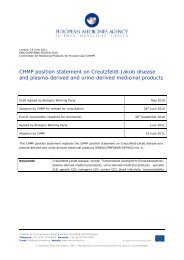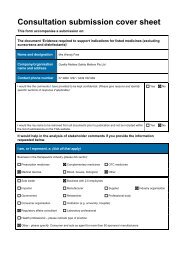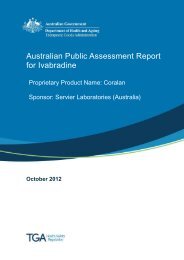Australian public assessment for Ibuprofen - Therapeutic Goods ...
Australian public assessment for Ibuprofen - Therapeutic Goods ...
Australian public assessment for Ibuprofen - Therapeutic Goods ...
Create successful ePaper yourself
Turn your PDF publications into a flip-book with our unique Google optimized e-Paper software.
AusPAR Caldolor <strong>Ibuprofen</strong> Phebra Pty Ltd PM-2010-02393-3-1<br />
Final 2 January 2013<br />
<strong>Therapeutic</strong> <strong>Goods</strong> Administration<br />
Finally, while it might possibly be relevant to the use of Caldolor specifically in patients<br />
with malaria, it does not represent a safety issue that would be relevant to the most of the<br />
anticipated usage of Caldolor in Australia.<br />
Sample size<br />
A sample size of 60 patients (30 per treatment) was planned. Based on incomplete data<br />
from a published study, it was hoped that this would be sufficient to detect a betweentreatment<br />
difference in AUC-T0-24 of 12°C×h. An interim analysis was originally planned to<br />
adjust the sample size if necessary but was cancelled prior to unblinding.<br />
Randomisation and blinding methods<br />
Randomisation to Caldolor 400 mg or placebo was on a 1:1 basis. Randomisation and<br />
blinding methods were the same as in CPI-CL-004.<br />
Analysis populations<br />
The Safety Analysis Population (SAP) comprised all randomised patients who received at<br />
least one dose of study medication.<br />
The ITT population included all patients from the safety population who had a baseline<br />
<strong>assessment</strong> and at least one post-baseline evaluation of the primary endpoint.<br />
The EEP included all patients from the ITT population who had no major protocol<br />
violations with regard to inclusion and exclusion criteria, and who had the required<br />
primary efficacy <strong>assessment</strong>s (temperature measurements in the first 24 h after the start<br />
of study treatment). If 2 or more consecutive temperature measurements were missing in<br />
the first 24 hs, the patient was not eligible <strong>for</strong> inclusion in the EEP.<br />
Statistical methods<br />
All statistical tests were two-sided, with p-values less than 0.05 <strong>for</strong> treatment differences<br />
considered significant.<br />
The primary outcome was to be analysed in the ITT population with a supportive analysis<br />
in the EEP. Secondary outcomes were to be analysed only in the EEP. However, the EEP<br />
included all 60 randomised patients, so all outcomes were, in effect, analysed in the ITT<br />
population. Missing temperature values were imputed by linear interpolation or LOCF as<br />
previously described <strong>for</strong> the primary endpoint. Patients who received rescue treatment<br />
were withdrawn from study medication and temperature measurements subsequent to<br />
recue treatment were substituted with the mean of the treatment group temperature <strong>for</strong><br />
that corresponding time point.<br />
Participant flow<br />
The study report did not state the number of prospective participants who were screened.<br />
A total of 60 patients were randomised and progressed as follows:<br />
SAP: 60 patients received study medication and were included in the SAP.<br />
ITT: All 60 patients in the SAP were included in the ITT population.<br />
EEP: The EEP included all 60 patients from the ITT.<br />
A total of 59 patients completed the entire study. One patient in the Caldolor 400 mg<br />
group completed the 5-day treatment period but filed to return from the Day 21 follow-up.<br />
Table 12 summarises the disposition of patients according to treatment group and<br />
analysis population.<br />
Page 38 of 118
















